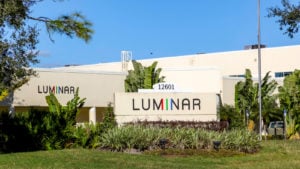Many startups are growing rapidly and can deliver significant returns if they sustain a high performance and grow their businesses to become major players in their respective sectors eventually.
That said, there is definitely an oversized risk with penny growth stocks. But one of the most effective ways to mitigate this risk is by looking for penny growth stocks that are close to being profitable or have enough cash reserves to fund operations until profitability. Let’s look at the following three:
Terran Orbital (LLAP)

I have been keeping a close eye on Terran Orbital (NYSE:LLAP), a satellite company that has been taking investors on a wild ride since 2022. LLAP stock plunged over 92% from its highs amid extreme market volatility. However, with a massive $2.6 billion backlog and contracts lined up with the likes of Lockheed Martin (NYSE:LMT), I believe Terran Orbital could stage an epic turnaround once macro conditions improve.
There’s no doubt LLAP is risky. Much of that backlog relies on one major customer, Rivada. If anything goes awry with Rivada’s contracted projects, it would deal a huge blow to Terran Orbital’s pipeline. Investors are also rightly concerned about profitability, even if Terran hits its $2 billion revenue target through 2025. Turning revenue into profits is no guarantee in the satellite business.
However, I believe much of this risk is already priced into LLAP’s ultra-low $170 million market cap. Compare that to the nosebleed valuations of other pre-revenue space companies. Terran Orbital at least has significant contracts in hand, even if execution remains uncertain. With a potential turnaround on the horizon, I think LLAP offers one of the best risk-reward setups among penny growth stocks today.
Luminar Technologies (LAZR)

Luminar Technologies (NASDAQ:LAZR) produces lidar sensors for autonomous vehicles. Like many electric vehicle stocks, LAZR has crashed hard amid the bear market. However, recent green shoots suggest a comeback could be brewing. If lidar becomes a must-have technology for self-driving cars, Luminar could see exponential growth.
Lidar does cost more than cameras today, but it offers superior range and precision for autonomy. As costs come down, lidar is expected to gain rapid mainstream adoption over the next decade. Luminar itself is targeting a $60 billion order book by 2030. Hitting that mark would likely turn LAZR into a juggernaut grower.
Of course, the path to profitability remains unclear. Luminar continues burning cash, though analysts expect it to turn profitable by 2026. If Luminar hits its goals, the forward P/E ratio could be just 1.26x in 2030 – an absolute steal for a company growing as quickly as Luminar anticipates.
In the meantime, however, shareholders should brace for plenty of volatility. Macro headwinds have slowed LAZR’s early growth. But with a huge long-term opportunity in lidar, I believe patience will pay off big time for investors willing to stomach the ups and downs.
Bitfarms (BITF)

As a Bitcoin (BTC-USD) miner, Bitfarms (NASDAQ:BITF) offers direct exposure to the world’s largest cryptocurrency. With Bitcoin surging in recent weeks amid several potential 2024 catalysts, I have turned increasingly bullish on BITF stock.
Next year, we could see Bitcoin ETF approval, which would open crypto investing to millions of new investors. The 2024 Bitcoin halving should also drive FOMO and propel prices higher based on historical trends. And if inflation keeps dropping, rate cuts could turbocharge crypto growth.
The halving will hamper Bitfarms’ near-term mining output. But historically, post-halving Bitcoin price surges have more than offset the supply shock for capable miners like BITF. With miners stockpiling Bitcoin to sell into future strength, the next halving could be a major tailwind if BTC holds true to form.
Make no mistake, BITF is speculative. Bitcoin remains a volatile asset, and regulatory risks always loom over cryptos. But with Bitcoin flashing so many positive signals as we head into 2024, I believe Bitfarms offers explosive upside potential for risk-tolerant investors over the next 12-18 months.
On the date of publication, Omor Ibne Ehsan did not hold (either directly or indirectly) any positions in the securities mentioned in this article. The opinions expressed in this article are those of the writer, subject to the InvestorPlace.com Publishing Guidelines.
